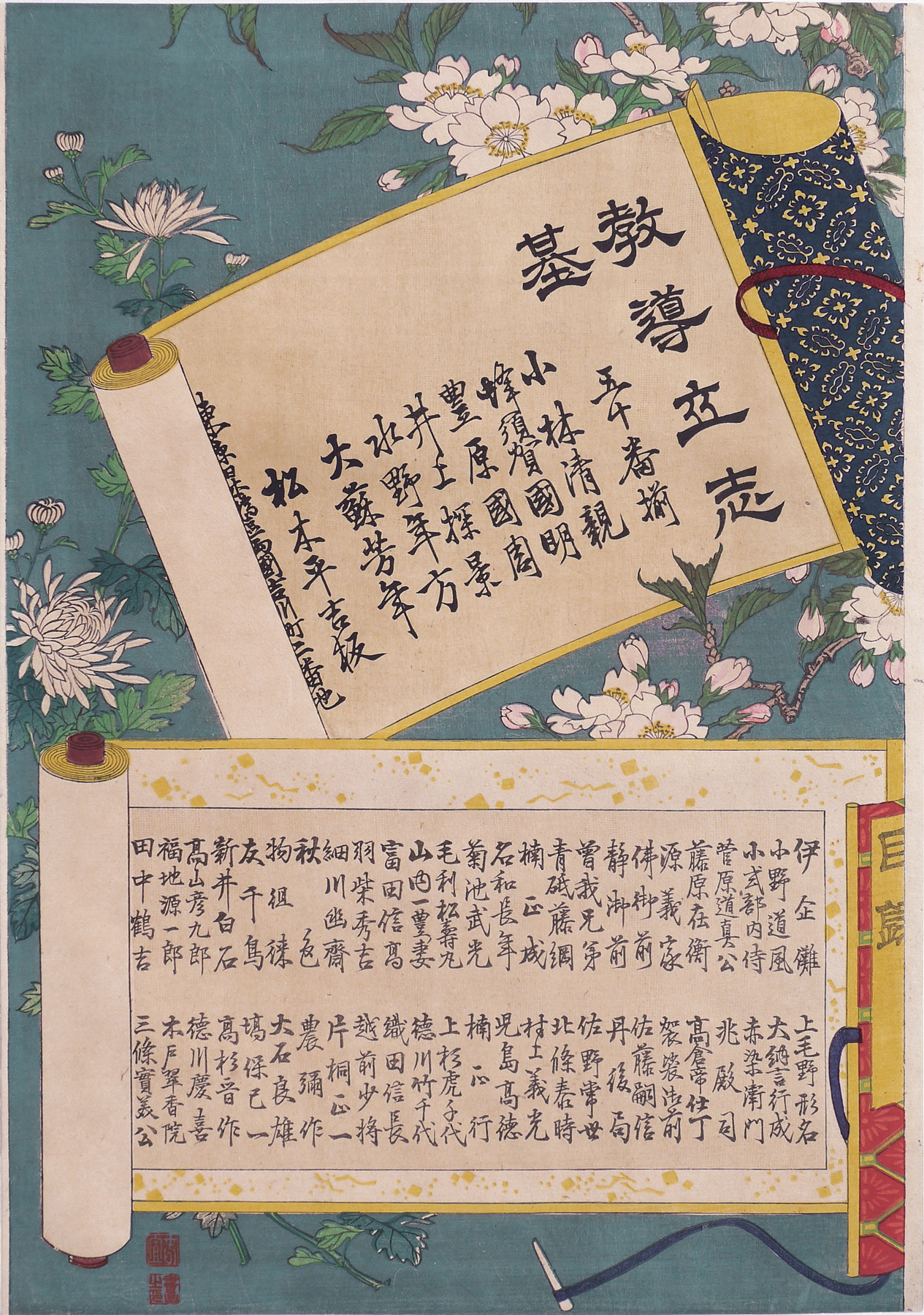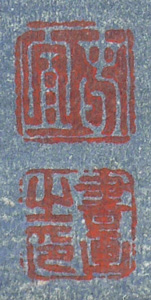About This Print
On two partially unrolled scrolls, this Table of Contents sheet (mokuroku) from the series Instructive Models of Lofty Ambition provides the names of the artists who contributed prints to the series, the name and address of the series' publisher and a list of all fifty prints that comprised the series as it was originally issued. As discussed in the article on this site "Instructive Models of Lofty Ambition," one additional artist Yōshū Chikanobu (1838-1912), whose name does not appear on the Table of Contents sheet (for unknown reasons), was commissioned to create two prints and the final number of prints issued was fifty-eight rather than fifty, including three prints not listed in the Table of Contents (the two Chikanobu designs and one design by Inoue Tankei) and five modified designs of originally issued prints.The bottom scroll is the table of contents, or index (目録) of prints in the series as originally issued. Reading from top right to bottom left, the titles provided are as follows:
| Position in table of contents | Title in Kanji | Title Translation |
| 1 | 伊企儺 | Ikina |
| 2 | 上毛野形名 | Kamitsukenu Katana |
| 3 | 小野道風 | Ono no Tōfū |
| 4 | 大納言行成 | Dainagon Yukinari |
| 5 | 小式部内侍 | Koshikibu no Naishi |
| 6 | 赤染衛門 | Akazome Emon |
| 7 | 菅原道真公 | Michizane Sugawara |
| 8 | 兆殿司 | Chōdensu |
| 9 | 藤原在衡 | Fujiwara no Arihira |
| 10 | 高倉帝仕丁 | Emperor Takakura’s Palace Servants |
| 11 | 源義家 | Minamoto no Yoshiie |
| 12 | 袈裟御前 | Kesa Gozen |
| 13 | 佛御前 | Hotoke Gozen |
| 14 | 佐藤嗣信 | Sato Tsugunobo |
| 15 | 静御前 | Shizuka Gozen |
| 16 | 丹後局 | Tango no Tsubone |
| 17 | 曾我兄弟 | Soga Brothers |
| 18 | 佐野常世(丗) | Sano Tsuneyo |
| 19 | 青砥藤綱 | Aoto Fujitsuna |
| 20 | 北条(條)泰時 | Hōjō Yasutoki |
| 21 | 楠正成 | Kusunoki Masashige |
| 22 | 村上義光 | Murakami Yoshiteru |
| 23 | 名和長年 | Nawa Nagatoshi |
| 24 | 児島高徳 | Kojima Takanori |
| 25 | 菊池武光 | Takemitsu Kikuchi |
| 26 | 楠正行 | Kusunoki Masatsura |
| 27 | 毛利松寿丸 | Mori Shōjumaru |
| 28 | 上杉虎千代 | Uesugi Torachiyo |
| 29 | 山内一豊妻 | Yamanōchi Kazutoyono tsuma |
| 30 | 徳川竹千代 | Tokugawa Takechiyo |
| 31 | 富田信高 | Tomita Nobutaka |
| 32 | 織田信長 | Obu Nobunaga |
| 33 | 羽柴秀吉 | Hashiba Hideyoshi |
| 34 | 越前少将 | Echizen Shōshō |
| 35 | 細川幽斎 | Hosokawa Yūsai |
| 36 | 片桐正一 | Katagiri Shoichi |
| 37 | 秋色 | Shūshiki |
| 38 | 農弥作 | Farmer Yasaku |
| 39 | 物徂徠 | Butsu Sorai |
| 40 | 大石良雄 | Ooishi Yoshio |
| 41 | 友千鳥 | Tomochidori |
| 42 | 塙保己一 | Hanawa Hokiichi |
| 43 | 新井白石 | Arai Hakuseki |
| 44 | 高杉晋作 | Takasugi Shinsaku |
| 45 | 高山彦九郎 | Takayama Hikokurō |
| 46 | 徳川慶喜 | Tokugawa Yoshinobu |
| 47 | 福地源一郎 | Genichiro Fukuchi |
| 48 | 木戸翠香院 | Kido Suikō-in |
| 49 | 田中鶴吉 | Tanaka Tsurukichi |
| 50 | 三條實美公 | Sanjō Sanetomi |
The design of the table of contents sheet is credited to the relatively unknown artist Hishikawa Harunobu (active 1875-1891), who designed at least one print of a sumo champion for the publisher Matsuki Heikichi. (See details under Signature in the table "Print Details" below.)
About The Series "Kyōdō risshi no motoi"
Note: This series is variously translated as "Instructive Models of Lofty Ambition," "Foundations of Learning and Achievement," "Foundation of Instruction and Perseverance," "Self-Made Men Worthy of Emulation," "Paragons of Instruction and Success," "Moral of Success," "Examples of Self-Made Leaders," and "Instruction in the Fundamentals of Success." The title in Japanese is sometimes seen as "Kyōdō risshiki" or "Kyōdō risshi no moto."
Source: Kiyochika Artist of Meiji Japan, Henry D. Smith II, Santa Barbara Museum of Art, 1988, p. 74-75; original research and as footnoted.
This series of 58 prints,1 plus a table of contents sheet (目録), were originally published between October 1885 and November 1890 by the Tokyo publisher Matsuki Heikichi 松木平吉.2 The table of contents sheet issued by the publisher states that "fifty prints make up the complete set (五十番揃)". Three prints not in the initial release were added over the five year publication period, as were five redesigns of original prints, eventually increasing the total print count to 58. The seven artists contributing prints were Kobayashi Kiyochika (1847-1915) [20 prints], Mizuno Toshikata (1866-1908) [16 prints], Inoue Tankei (Yasuji) (1864-1889) [13 prints], Taiso (Tsukioka) Yoshitoshi (1839-1892) [4 prints], Yōshū Chikanobu (1838-1912) [2 prints], Toyohara Kunichika (1835–1900) [1 print], and Hachisuka (Utagawa) Kuniaki II (1835-1888) [1 print]. All the artists, with the exception of Yōshū Chikanobu, are listed in the top scroll of the table of contents sheet. Various colors (blue, blue/green and brown) were used for the decorative border, and in 1902 the series was re-issued by Matsuki without borders.
The series depicts famous individuals throughout Japanese history, from ancient times to the present, i.e. c. 1895. Brief texts contained within a scroll-like cartouche appearing on each print provide historical details. The “lofty ambition” of the title is a Confucian concept, originally from Mencius, meaning “righteous determination that would inspire others.” The market for the series probably included former samurai, ambitious youth, and conservative intellectuals.
"[W]hen it was completed in 1890 the publisher was singled out for special recognition by the government for having sponsored such noble subject matter."3
The series was re-issued in 1902 by the original publisher without the brocade border.
1 The Tokyo Metropolitan Library online collection shows 50 prints and a summary catalog sheet. The catalog sheet lists the titles of 50 prints. Smith in Kiyochika Artist of Meiji Japan identified 52 prints. I have identified 58 prints from this series including five prints (Ikina, Michizane Sugiwara, Kesa Gozen, Soga Brothers and Hokiichi Hanawa) that were re-designed and re-printed, likely due to damaged or lost blocks.
2 Robert Schaap notes in Appendix II, p. 166 of Yoshitoshi, Masterpieces from the Ed Freis Collection, Chris Uhlenbeck and Amy Reigle Newland, Hotei Publishing, 2011 that the series originally appeared as newspaper supplements.
3 The World of the Meiji Print: Impressions of a New Civilization, Julia Meech-Pekarik, Weatherhill, 1986, p. 122.
Source: Kiyochika Artist of Meiji Japan, Henry D. Smith II, Santa Barbara Museum of Art, 1988, p. 74-75; original research and as footnoted.
This series of 58 prints,1 plus a table of contents sheet (目録), were originally published between October 1885 and November 1890 by the Tokyo publisher Matsuki Heikichi 松木平吉.2 The table of contents sheet issued by the publisher states that "fifty prints make up the complete set (五十番揃)". Three prints not in the initial release were added over the five year publication period, as were five redesigns of original prints, eventually increasing the total print count to 58. The seven artists contributing prints were Kobayashi Kiyochika (1847-1915) [20 prints], Mizuno Toshikata (1866-1908) [16 prints], Inoue Tankei (Yasuji) (1864-1889) [13 prints], Taiso (Tsukioka) Yoshitoshi (1839-1892) [4 prints], Yōshū Chikanobu (1838-1912) [2 prints], Toyohara Kunichika (1835–1900) [1 print], and Hachisuka (Utagawa) Kuniaki II (1835-1888) [1 print]. All the artists, with the exception of Yōshū Chikanobu, are listed in the top scroll of the table of contents sheet. Various colors (blue, blue/green and brown) were used for the decorative border, and in 1902 the series was re-issued by Matsuki without borders.
The series depicts famous individuals throughout Japanese history, from ancient times to the present, i.e. c. 1895. Brief texts contained within a scroll-like cartouche appearing on each print provide historical details. The “lofty ambition” of the title is a Confucian concept, originally from Mencius, meaning “righteous determination that would inspire others.” The market for the series probably included former samurai, ambitious youth, and conservative intellectuals.
"[W]hen it was completed in 1890 the publisher was singled out for special recognition by the government for having sponsored such noble subject matter."3
The series was re-issued in 1902 by the original publisher without the brocade border.
1 The Tokyo Metropolitan Library online collection shows 50 prints and a summary catalog sheet. The catalog sheet lists the titles of 50 prints. Smith in Kiyochika Artist of Meiji Japan identified 52 prints. I have identified 58 prints from this series including five prints (Ikina, Michizane Sugiwara, Kesa Gozen, Soga Brothers and Hokiichi Hanawa) that were re-designed and re-printed, likely due to damaged or lost blocks.
2 Robert Schaap notes in Appendix II, p. 166 of Yoshitoshi, Masterpieces from the Ed Freis Collection, Chris Uhlenbeck and Amy Reigle Newland, Hotei Publishing, 2011 that the series originally appeared as newspaper supplements.
3 The World of the Meiji Print: Impressions of a New Civilization, Julia Meech-Pekarik, Weatherhill, 1986, p. 122.
Print Details
| IHL Catalog | #1071 |
| Title or Description | Table or Contents or Index (目録 mokuroku) |
| Series | “Instructive Models of Lofty Ambition” (Kyōdō risshiki 教導立志基) [note: series title also listed as 'Kyōdō risshi no moto', ‘Kyōdō risshi no motoi’, ‘Kyōdō risshi ki’ and variously translated a"Foundations of Learning and Achievement," "Foundation of Instruction and Perseverance," "Self-Made Men Worthy of Emulation," "Paragons of Instruction and Success," "Moral of Success," "Examples of Self-Made Leaders," and "Instruction in the Fundamentals of Success."] |
| Artist | Hishikawa Harunobu (active 1875-1891) |
| Signature | bottom seal: 書画之印 shoga no in (paintings and writings of calligraphy) top seal: 春宣 (Harunobu) |
| Seal | |
| Publication Date | undated, but likely c. 1890 |
| Publisher | Matsuki Heikichi (松木平吉) proprietor of Daikokuya [Marks: seal not shown; pub. ref. 029] |
| Carver | |
| Printer | |
| Impression | excellent |
| Colors | excellent |
| Condition | excellent - Japanese album backing paper; very minor marks and flaws; slight trimming to border |
| Genre | ukiyo-e |
| Miscellaneous | |
| Format | vertical oban |
| H x W Paper | 13 7/8 x 9 3/4 in. (35.2 x 24.8 cm) |
| H x W Image | 13 7/8 x 9 7/16 in. (35.2 x 24 cm) |
| Literature | |
| Collections This Print | Tokyo Metropolitan Library 5261-K2; Tokyo Digital Museum (Edo-Tokyo Museum) 96200361; Smithsonian Institution Freer Gallery of Art and Arthur M. Sackler Gallery S1995.116 |



